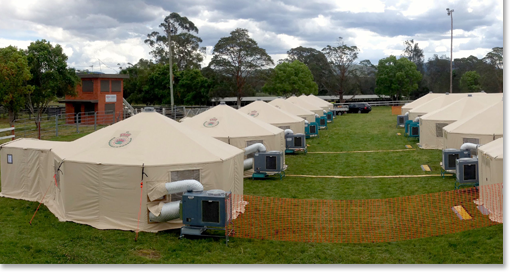
‘We have been providing power and air conditioning at emergency camps all over Australia for a number of years now.’ notes Brad. ‘When we get the call our main focus is on getting the emergency camp up and running as quickly as possible. This lets the Firies focus on fighting fires and have a comfortable camp where they can rest and recoup before their next shift. It also gives displaced victims a safe haven from what are often very traumatic situations.’
Emergency camps are usually located in remote, open fields so robust planning and clear communication is vital. ‘The camp sites are a hive of activity’ says Brad. ‘So everyone needs to know what the overall plan is and who is responsible.’
Working in close collaboration the contractors, Rural Fire Service and Active Air team firstly design an optimised camp layout and site plan. This ensures equipment and cables are in the most logical and efficient positions and it also prevents double handling. The best layouts start with the power generator placement. Too close to the sleeping tents and people won’t get their rest, too far and it will mean excess cabling.
Brad explains, ‘More cables mean more energy, and more energy means more cost. This is because excess cables create amp-drop resulting in wasted fuel and / or the need for larger generators. By optimising cable requirements it saves the client on hire and fuel costs.’
The team then physically marks out where each piece of equipment will go, where the tents will be placed, the power distribution lines and how the power load will be balanced between generators.
‘We’ve also designed our equipment to be simple and easy to transport and set up. We have palletised all our gear and incorporated powerlock fitting on all our generators and boards, foregoing the need for excess electricians on site. This allows for a faster and more efficient installation.’ Says Brad.
Depending on the scale of the fire the camps can include a mess hall, day and night sleeping quarters, mobile command centres, admin and media tents.
Each tent’s use dictates how many and what type of air conditioners are needed. ‘For example, day-sleeper tents for the Firies need a lot of air conditioning to combat the heat of the day, where as the night-sleeper tents need a lot less air conditioning because it’s cooler at night.’ Explains Brad.
Sizing the air conditioning correctly provides comfortable sleeping conditions whist also minimising the generator loads, saving dollars and extending refueling timeframes.
‘Mess halls are very large open marquee-type tents so the type of air conditioners and ducting is different to what we use for sleeping quarters.’
‘Equally, power requirements are different for each type of tent. Media and admin tents need more power than sleeping quarters. Where as in the displaced victims’ camps they need a lot more single phased cables so everyone can charge their cell phones. We are also more focused on ensuring the public’s safety so may use different distribution routes and a lot more cable covers.’
‘Ultimately we focus on quick, simple and effective set ups to give the brave men and women in the Rural Fire Service, and victims, a place of respite.’
About Active Air Rentals
Active Air Rentals is Australia’s all round cooling, heating and power rental company. Specialising in hire and rental of temporary air conditioning, power generation, climate control and refrigeration equipment.
Founded in 1972 by Managing Director, Jim Sweeny, Active Air Rentals has grown from humble beginnings as air conditioner installers and sheet metal manufacturers, to an all round national cooling, heating and power rental company.
Active Air Rentals is renowned for providing outstanding service, excellent customer relationships and addressing difficult, unusual or specialised projects.
Active Air Rentals has over 40 years experience installing temporary air conditioning into every conceivable location. From crane towers to coal mines, from war ships to entire inner city villages, from emergency civil defence camps to enormous events such as the Australian Open and thousands of offices and server rooms along the way.
Ready to start your project?
Time To Get Active.

